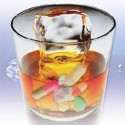Time for Drug Treatment to Rattle Its Saber
In an effort to recast substance abuse as more of a public health problem than a crime, the nation’s newly appointed drug czar has called for an end to talk of a “war on drugs.”
“Regardless of how you try to explain to people it’s a ‘war on drugs’ or a ‘war on a product,’ people see a war as a war on them,” Gil Kerlikowske, director of the White House Office of National Drug Control Policy, told the Wall Street Journal last week.
But is the problem really the use of a war analogy — or should public health advocates simply learn to use the lingo as effectively as law enforcement officials do?
In testimony before the House Judiciary Committee last week, Attorney General Eric H. Holder Jr. spoke of “targeting” Mexican drug cartels and “deploying” more federal agents to the Southwestern border, and he said a multinational task force delivered a “significant blow” to the narcotics trade when it seized 23 tons of illegal drugs during “Operation Xcellerator.”
That kind of talk gets attention — not to mention the resources for an all-out law enforcement- style war on drugs. Public health experts ought to try it.
On the same day that Holder testified, the journal Neuron published a study that was arguably more significant than any drug bust. Neuroscientists had broken new ground in the search for a medication to treat cocaine addiction. But scientific jargon doesn’t always fire the public imagination.
“We showed that blocking the activity of the sirtuins specifically in the nucleus accumbens reduced both cocaine’s rewarding effects and the motivation to self- administer the drug,” the lead researcher, Eric Nestler of Mount Sinai School of Medicine in New York, said in a news release.
Let’s put that in the context of a public health “war on drugs.” What Nestler and his team did was stage a rescue mission inside a cocaine-occupied brain. Like law enforcement officers, they used high-tech detection techniques to spot their target — a molecular drug distribution network that had corrupted a “family of genes,” causing behaviors characteristic of drug addiction.
Under normal conditions, these genes would help mediate the brain’s reward and motivation centers. But under the influence of cocaine, they began wreaking drug-craving havoc. Eventually, researchers figured out how to prevent the cocaine from affecting the genes, thereby restoring peace of mind.
Mission accomplished.
“You can see a drug as an enemy that is attacking the brain, attacking the identity of the person,” Nora Volkow, director of the National Institute on Drug Abuse, told me. “The term ‘war on drugs’ doesn’t necessarily equate with enforcement but can be used to communicate the devastating effects that drugs can have on a person, a family and a community.”
Nestler, whose research was funded by the NIDA, told me: “Sometimes, drug-addicted people are battling against very powerful biological forces, and without addressing those forces, drug rehabilitation and treatment programs just don’t work.”
A medication that reinforces drug treatment programs could be a decisive weapon in the war on drugs, he says.
You’d think that such a promising strategy would merit resources comparable to those given to law enforcement. But the disparities could hardly be starker. This year, the Obama administration plans to invest $700 million to “enhance Mexican law enforcement and judicial capacity,” as Holder put it. That’s more than double the NIDA’s annual budget for research.
As Homeland Security Secretary Janet Napolitano told the Senate Judiciary Committee this month, Mexican cartels have infiltrated as many as 230 U.S. cities and now represent the most serious organized crime threat to the United States. In other words, the horse is already out of the barn.
According to the 2006 National Survey on Drug Use and Health, 6 million people 12 and older used cocaine in the previous year, and 2.4 million were current users.
So the question is not so much how to stop the drugs from getting into the country as how to stop the drugs from getting inside of us. Reduce the demand and the supply takes care of itself.
Kerlikowske, the drug czar, said he wants to see more emphasis put on drug treatment and less on incarceration for nonviolent drug offenses. “We are not at war with people in this country,” he told the Journal.
But a battle rages nonetheless. And he’ll need to rally the troops. For the foe is cunning, capturing the brain. In a war, that would be the strategic high ground, and it must be retaken if we are to win.
source: Washington Post

